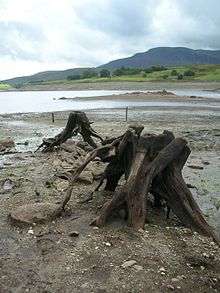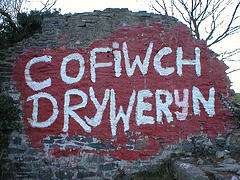Capel Celyn

Capel Celyn was a rural community to the north west of Bala in Gwynedd, north Wales, in the Afon Tryweryn valley. The village and other parts of the valley were flooded to create a reservoir, Llyn Celyn, in order to supply Liverpool and Wirral with water for industry.[1] The village contained, among other things, a chapel, as the name of the community suggests, capel being Welsh for chapel.
History
.jpg)
In 1956, a private bill sponsored by Liverpool City Council was brought before Parliament to develop a water reservoir from the Tryweryn Valley. The development would include the flooding of Capel Celyn. By obtaining authority via an Act of Parliament, Liverpool City Council would not require planning consent from the relevant Welsh local authorities. This, together with the fact that the village was one of the last Welsh-only speaking communities, ensured that the proposals became deeply controversial. Thirty-five out of thirty-six Welsh Members of Parliament (MPs) opposed the bill (the other did not vote), but in 1957 it was passed. The members of the community waged an eight-year effort, ultimately unsuccessful, to prevent the destruction of their homes.
When the valley was flooded in 1965, the village and its buildings, including the post office, the school, and a chapel with cemetery, were all lost. Twelve houses and farms were submerged, and 48 people of the 67 who lived in the valley lost their homes.[2] In all some 800 acres (3.2 km²; 320 ha) of land were submerged. A new reservoir, Llyn Celyn, was formed. Many of the stones from the original chapel were re-used in the construction of the new Memorial Chapel.
The water in the reservoir is used to maintain the flow of the Afon Dyfrdwy (River Dee, Deva Fluvius) so that water may be abstracted downstream,[3] and additionally to improve the quality of white-water sports on Afon Tryweryn.
A full list of the submerged properties (from largely west to east) is as follows –
| Moelfryn | Gwerndelwau |
| Glan Celyn + y Llythyrdy (Post Office) | Y Capel (Chapel) |
| Y Fynwent (Cemetery) | Tŷ Capel (Chapel House) |
| Tynybont | Yr Ysgol (School) |
| Brynhyfryd | Y Gelli |
| Cae Fadog | Penbryn Fawr |
| Coed Mynach | Dol Fawr |
| Garnedd Lwyd | Hafod Fadog (Quaker meeting place) + Mynwent y Crynwyr (The Quakers' Cemetery) |
| Y Tyrpeg (The Turnpike) | Tyddyn Bychan |
Families who had relatives buried in the cemetery were given the option of moving them to another cemetery. Consequently, eight bodies were disinterred and the remainder left. All headstones were supposed to be removed, and the cemetery was to be covered in a layer of gravel, then concrete, but this was not done.[2] When the reservoir dried due to a drought in the 1980s and early 1990s the village became visible. The whole of the walled cemetery next to where the chapel stood was completely covered in concrete. There were no gravestones left standing. The removed headstones can be seen at the new chapel at the Bala end of the lake.
Hafod Fadog
One of the farmsteads covered was Hafod Fadog, a Quaker meeting place. It is recorded on a bronze plaque in a lay-by near to the dam:
Under these waters and near this stone stood Hafod Fadog, a farmstead where in the seventeenth and eighteenth centuries Quakers met for worship. On the hillside above the house was a space encircled by a low stone wall where larger meetings were held, and beyond the house was a small burial ground. From this valley came many of the early Quakers who emigrated to Pennsylvania, driven from their homes by persecution to seek freedom of worship in the New World.
Political effects
The building of the reservoir was instrumental in an increase in support for the Welsh nationalist party, Plaid Cymru, during the late 1950s. Almost unanimous Welsh political opposition had failed to stop approval of the scheme, a fact that seemed to underline Plaid Cymru's argument that the Welsh national community was powerless.[4] At the subsequent General Election the party's support increased from 3.1% to 5.2%.

Of perhaps greater significance, however, was the impetus the episode gave to Welsh devolution. The Council of Wales recommended the creation of a Welsh Office and Secretary of State for Wales early in 1957, a time when the governance of Wales on a national level was so demonstrably lacking in many people's eyes.[6] By 1964 the Wilson Government gave effect to these proposals.
The flooding of Capel Celyn also sharpened debate within Plaid Cymru about the use of direct action. While the party emphasised its constitutional approach to stopping the development, it also sympathised with the actions of two party members who (of their own accord) attempted to sabotage the power supply at the site of the Tryweryn dam in 1962.[6]
A more militant response was the formation of Mudiad Amddiffyn Cymru or MAC, which blew up a transformer on the dam construction site in February 1963. MAC went on to carry out a number of other bombings in the next six years.
In October 1965 the Llyn Celyn reservoir opened to a sizeable Plaid Cymru organised demonstration. A year later, Gwynfor Evans won Plaid Cymru's first Parliamentary seat in Carmarthen. According to some commentators though, Capel Celyn did not play a major part in Gwynfor Evans's victory, since apart from Carmarthen's distance from Tryweryn, they claim that Plaid Cymru's victory owed as much to an anti-Labour backlash in the constituency's mining communities as it did to Plaid's successful depiction of Labour's policies as being a threat to the viability of small Welsh communities.[7][8]
On 19 October 2005, Liverpool City Council issued a formal apology for the flooding.[9][10] Some in the town of Bala welcomed the move, though others said the apology was a "useless political gesture" and came far too late.[11]
Cultural References
The flooding of the village inspired a Manic Street Preachers song "Ready For Drowning"[12] and Enya's song "Dan y Dŵr".[13] It is referenced in the Los Campesinos! song "For Flotsam" on their album No Blues.[14] To commemorate the 50th anniversary of the event, British composer, Michael Stimpson, released an album entitled "Dylan & The Drowning of Capel Celyn", which featured a work for solo pedal harp, inspired by the flooding.
The events provide inspiration for the eleventh episode "Achub Y Morfilod" in Season 6 of the American animation series Archer. Gueststarring Matthew Rhys, a native Welshman, the episode was the result of a story told by Rhys on a night out with the shows creators (earning Rhys a writing credit).[15]
See also
References
- ↑ http://www.bbc.co.uk/news/uk-wales-34528336
- 1 2 Capel Celyn, Ten Years of Destruction: 1955–1965, by Einion Thomas, published by Cyhoeddiadau Barddas & Gwynedd Council, 2007, ISBN 978-1-900437-92-9
- ↑ "Core Management Plan including Conservation Objectives for River Dee and Bala Lake / Afon Dyfrdwy a Llyn Tegid SAC". Countryside Council for Wales. 15 April 2008. Retrieved 5 February 2013.
- ↑ Davies, J, A History of Wales, (1990, rev. 2007), Penguin
- ↑ "BBC News – Wales – Mid Wales – Dam graffiti wall set to be saved". BBC News website. BBC News. 2006-10-17. Retrieved 2009-06-21.
- 1 2 Butt-Phillip, A, The Welsh Question, (1975), University of Wales Press
- ↑ Francis, H and Smith, D, The Fed: A History of the South Wales Miners in the Twentieth Century, (1980), University of Wales.
- ↑ Tanner, D, Facing the New Challenge: Labour and Politics 1970 – 2000 in The Labour Party in Wales 1900–2000 (Ed. Tanner, D, Williams, C and Hopkin, D), (2000), University of Wales Press
- ↑ "Official apology over Tryweryn", BBC News, 19 October 2005.
- ↑ "Liverpool says sorry for flooding Welsh valley", Guardian, 13 October 2005.
- ↑ "City apology '40 years too late'", BBC News, 19 October 2005.
- ↑ How Green Is My Valley copy of Select magazine review, November 1998, at thisisyesterday.com
- ↑ "Liner notes from The Celts album", Roma Ryan, 1993. Archived October 19, 2011, at the Wayback Machine.
- ↑ http://pitchfork.com/reviews/albums/18676-los-campesinos-no-blues/
- ↑
16. 'Hands Off Wales', Wyn Thomas, Gomer, 2013.
External links
- Picture gallery
- Photos of the protest at BBC Liverpool
- National Library of Wales page on Tryweryn
- Capel Celyn and other Welsh communities flooded to create reservoirs
Coordinates: 52°57′11″N 3°42′50″W / 52.953°N 3.714°W
